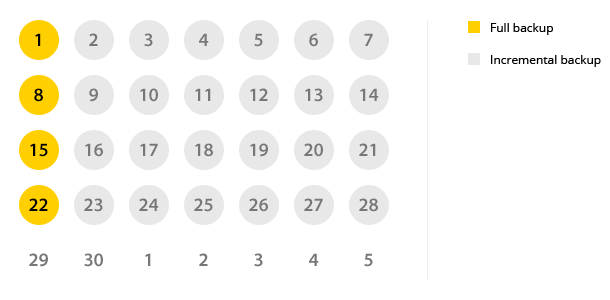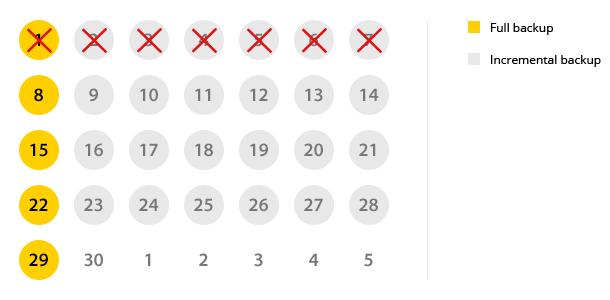The practice of backing up AD can lead to high storage costs and compliance issues if your older and unnecessary backups are not promptly deleted. Backups should only be held in the repository until they reach their retention period as defined by organizational standards. To ease this backup management problem, RecoveryManager Plus allows you to create a backup retention policy that automates the process of discarding older backups.
A backup retention policy is an organizational or governmental mandate that outlines how long backup data should be retained. A retention policy includes many requirements such as the type of data to be backed up, where the backup data has to be stored, the number of backup versions to be stored concurrently, the oldest possible age for backups, and more.
RecoveryManager Plus’s backup retention feature allows you to define the number of full backups to be retained in your repository at any given time. When the number of full backups in your repository exceeds the specified number, the oldest full backup and its associated incremental backups will be deleted.
RecoveryManager Plus allows you to take a full backup of your AD every week or month, depending on your need. When you configure backup settings for a domain, you can specify the number of full backups to retain. Multiple incremental backups, either scheduled or manual, can happen on the same day, but they do not trigger the retention policy.
Assume you have the following backup settings configured: a backup retention count of four backups, incremental backups scheduled to run daily, and full backups set to run on the first day of each week.
In the above case, after the full backup on day one, RecoveryManager Plus will incrementally back up your AD for the next six days. RecoveryManager Plus will then take a full backup of your AD after six days of incremental backups, and the cycle will continue until the 28th day.

When RecoveryManager Plus performs a full backup for the fifth time on 29th, the backup retention count will have exceeded the limit you set, and the retention policy will take effect. The oldest full backup and all incremental backups corresponding to that full backup will be removed from your repository. While the retention policy is only based on the number of full backups to be retained, the incremental backups are also deleted since they cannot be used in the absence of the associated full backup.

With its backup retention feature, RecoveryManager Plus ensures you don't have older backups wasting your storage space.
Back up all objects in your Azure AD environment and instantly restore any object to their backed up state.
Learn moreBack up all items in your Exchange Online mailboxes and restore the entire mailbox or just a single mail based on your need.
Learn moreBack up all files and folders in your SharePoint Online sites and instantly restore any document version with their share permissions.
Learn moreBack up all files and folders in your OneDrive for Business sites and instantly restore files and their share permissions.
Learn moreBack up all mailboxes, contacts, calendar entries, and user drives and quickly restore any entity to its backed-up state.
Learn moreBack up all items in your Exchange mailboxes. Restore the entire mailbox or just a single mail based on your need.
Learn more